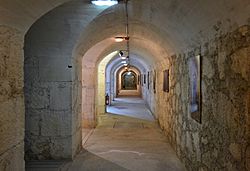Shelter of Cervantes facts for kids
| Refugi de Cervantes | |
 |
|
| Established | 1938 |
|---|---|
| Location | Calle els Alçamora nº 1 - Alcoy (Alicante), Spain |
| Type | Historical, Militar |
The Shelter of Cervantes is a special underground space. It was built during the Spanish Civil War to protect people from bombs. You can find it in the city of Alcoy, in Spain. This shelter was fixed up and opened as a museum on April 12, 2006.
Contents
What is the Cervantes Shelter?
The Cervantes Shelter is an air raid shelter. This means it was a safe place underground where people could hide. It protected them from bombs dropped by airplanes during a war. Today, it helps us remember an important time in history.
A Safe Place During the Spanish Civil War
The Spanish Civil War was a big conflict that happened in Spain from 1936 to 1939. During this war, many cities were bombed. Alcoy was one of these cities. To keep people safe, more than 25 shelters were built there.
Bombings in Alcoy
From September 1938 to January 1939, Alcoy was bombed many times. Airplanes from the Italian air force dropped bombs on the city. These planes were called Savoia SM 79. The shelters were very important for the people living in Alcoy.
Inside the Cervantes Shelter
The Cervantes Shelter is quite large. It is over 100 meters long and could hold 1,166 people. The shelter has eight long tunnels, called galleries. You could get into these tunnels through two main hallways.
Features of the Shelter
The shelter covers an area of 292 square meters. It had four toilets and two washbasins for people to use. There was also a special room for first aid. This room was for helping anyone who got hurt.
Warning Signs and Safety
When you enter the shelter, you walk down a long hallway. Here, you can still see an old sign. It says "es peligroso permanecer aqui" in Spanish. This means "it is dangerous to stay here." This warning was there because even underground, a very strong bomb blast could cause damage.
The Shelter as a Museum Today
In 2006, the Cervantes Shelter became a museum. Each of its eight tunnels now shows a different part of its history. The museum helps visitors understand what it was like during the bombings.
Learning About the Past
The museum has old maps and photos from the air attacks. There is an interactive screen where you can see military objects. You can also watch a video. This video shares stories from people who lived through the bombings in Alcoy. It helps us learn from their experiences.
See also
 In Spanish: Refugio-Museo de Cervantes para niños
In Spanish: Refugio-Museo de Cervantes para niños

